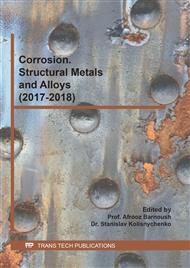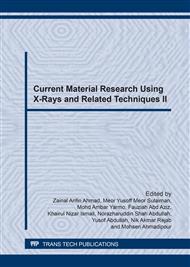[1]
F. Tian, P.J. Shang, Z.Q. Liu, Precise Cr-marker investigation on the reactive interface in the eutectic SnIn solder joint, Mater. Lett., 121(2014) 185–187.
DOI: 10.1016/j.matlet.2014.01.170
Google Scholar
[2]
Y. Zhang, Tin and tin alloys for lead-free solder, Mod. Electroplat. Fifth Ed., 139–204, (2011).
Google Scholar
[3]
M. Ishikawa, H. Sasaki, S. Ogawa, M. Kohinata, A. Mishima, H. Yoshida, Application of gold-tin solder paste for fine parts and devices, Proc. Electron. Components Technol. 2005. ECTC '05., Lake Buena Vista, FL, 2005, 701-709.
DOI: 10.1109/ectc.2005.1441346
Google Scholar
[4]
C. M. Miller, I.E. Anderson, J.F. Smith, A viable tin-lead solder substitute: Sn-Ag-Cu, J. Electron. Mater., 23(7) (1994) 595–601.
DOI: 10.1007/bf02653344
Google Scholar
[5]
X. Chen, A. Hu, M. Li, D. Mao, Effect of a trace of Cr on intermetallic compound layer for tin-zinc lead-free solder joint during aging, J. Alloys Compd., 470(1-2) (2009) 429–433.
DOI: 10.1016/j.jallcom.2008.02.112
Google Scholar
[6]
M.F.M. Nazeri, A.B. Ismail, A. A Mohamad, Effect of polarizations on Sn–Zn solders alloys in alkaline electrolyte, J. Alloys Compd., 606 (2014) 278–287.
DOI: 10.1016/j.jallcom.2014.04.034
Google Scholar
[7]
L. Zhang, K.N. Tu, Structure and properties of lead-free solders bearing micro and nano particles, Mater. Sci. Eng. R Reports, 82 (2014) 1–32.
DOI: 10.1016/j.mser.2014.06.001
Google Scholar
[8]
W. R. Osorio, E. S. Freitas, J. E. Spinelli, A. Garcia, Electrochemical behavior of a lead-free Sn-Cu solder alloy in NaCl solution, Corros. Sci., 80 (2014) 71–81.
DOI: 10.1016/j.corsci.2013.11.010
Google Scholar
[9]
Satyanarayan, K. N. Prabhu, Reactive wetting, evolution of interfacial and bulk IMCs and their effect on mechanical properties of eutectic Sn-Cu solder alloy, Adv. Colloid Interface Sci., 166(1-2) (2011) 87–118.
DOI: 10.1016/j.cis.2011.05.005
Google Scholar
[10]
G. Priyotomo, S. Wagle, K. Okitsu, A. Iwase, Y. Kaneno, R. Nishimura, T. Takasugi, The corrosion behavior of Ni 3(Si, Ti) intermetallic compounds with Al, Cr, and Mo in various acidic solutions, Corros. Sci., 60 (2012) 10–17.
DOI: 10.1016/j.corsci.2012.04.017
Google Scholar
[11]
M. Firdaus, M. Nazeri, A. Azmin, Corrosion resistance of ternary Sn-9Zn-xIn solder joint in alkaline solution, J. Alloys Compd., 661 (2016) 516–525.
DOI: 10.1016/j.jallcom.2015.11.184
Google Scholar
[12]
Z. Ahmad, Basic concepts in corrosion, in: Principles of Corrosion Engineering and Corrosion Control, Butterworth-Heinemann, Oxford, 2006, 9–56.
DOI: 10.1016/b978-075065924-6/50003-9
Google Scholar
[13]
X.L. Zhang, Z.H. Jiang, Z.P. Yao, Y. Song, Z.D. Wu, Effects of scan rate on the potentiodynamic polarization curve obtained to determine the Tafel slopes and corrosion current density, Corros. Sci., 51(3) (2009) 581–587.
DOI: 10.1016/j.corsci.2008.12.005
Google Scholar
[14]
U.S. Mohanty, K. L. Lin, Effect of Al on the electrochemical corrosion behaviour of Pb free Sn-8. 5 Zn-0. 5 Ag-XAl-0. 5 Ga solder in 3. 5% NaCl solution, Appl. Surf. Sci., 252(16), (2006) 5907–5916.
DOI: 10.1016/j.apsusc.2005.08.020
Google Scholar



